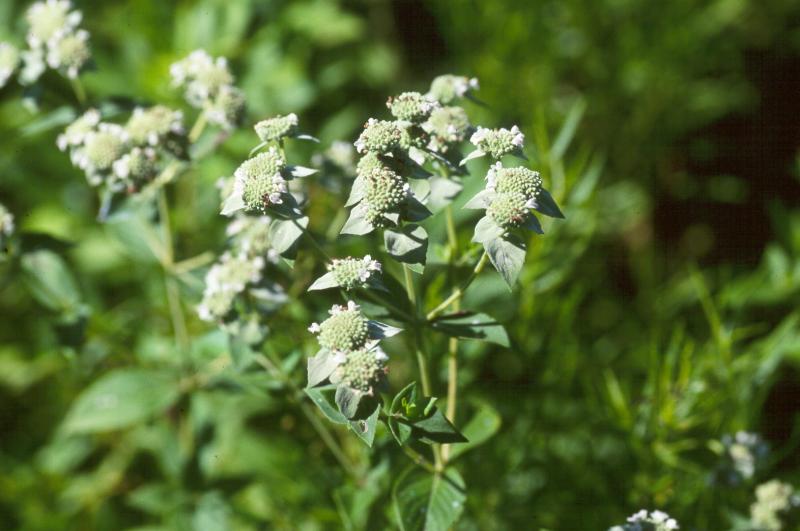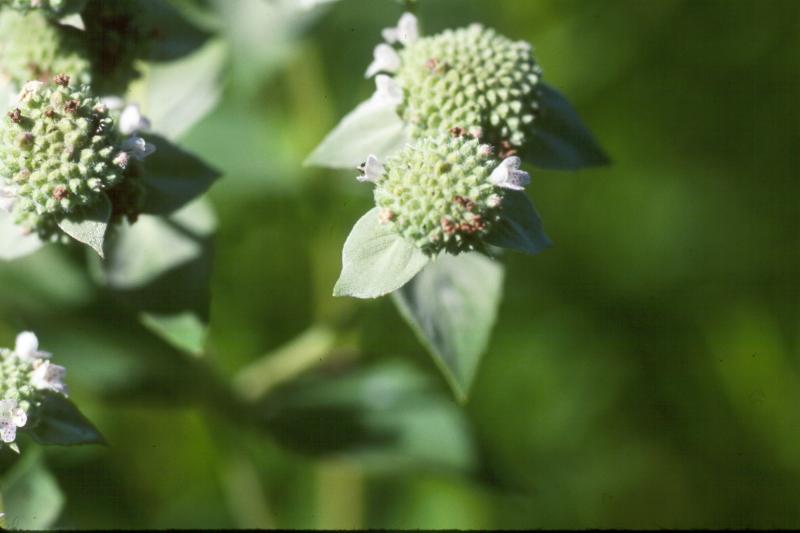Blunt Mountain Mint
Pycnanthemum muticum (Michx.) Pers.
- Class
- Dicotyledoneae (Dicots)
- Family
- Lamiaceae (Mint Family)
- State Protection
- Threatened
Listed as Threatened by New York State: likely to become Endangered in the foreseeable future. For animals, taking, importation, transportation, or possession is prohibited, except under license or permit. For plants, removal or damage without the consent of the landowner is prohibited.
- Federal Protection
- Not Listed
- State Conservation Status Rank
- S2S3
Imperiled or Vulnerable in New York - Very vulnerable, or vulnerable, to disappearing from New York, due to rarity or other factors; typically 6 to 80 populations or locations in New York, few individuals, restricted range, few remaining acres (or miles of stream), and/or recent and widespread declines. More information is needed to assign either S2 or S3.
- Global Conservation Status Rank
- G5
Secure globally - Common in the world; widespread and abundant (but may be rare in some parts of its range).
Summary
Did you know?
Butterflies favor this plant because it is a good source of nectar. (Pycnanthemum muticum in American Beauties Native Plants fact sheet, accessed 16 November 2007). The leaves have a strong mint fragrance that can even be smelled in museum specimens decades old.
State Ranking Justification
There are 11 existing populations but most of them have fewer than 50 plants. There are about 10 historical records but many of these are from developed areas from New York City to Long Island and around Rochester. More populations could be found as its habitat preferences are better understood.
Short-term Trends
More survey work is needed to understand the short-term trends since most populations have only been surveyed once.
Long-term Trends
Most of the original historical records are from areas that have been developed but new populations have been discovered to keep the total number of populations about the same over time.
Conservation and Management
Threats
For plants located close to the road any construction from the road may negatively impact the population if the road crew is not made aware of its presence. More studies are needed to determine if run-off from the road is a threat. Other populations are located close to human activity which may inadvertently harm plants.
Conservation Strategies and Management Practices
Avoid mowing plants along roadsides during the growing season. Establish sufficient buffers around populations to preserve the undisturbed aspect and hydrology of their habitat.
Research Needs
Research is needed to determine what is limiting the spread of this species since there seems to be plenty of habitat into which it could grow.
Habitat
Habitat
In New York most of our extant sites for Pycnanthemum muticum consist of wet, sandy, coastal habitats. These include wet swales between dunes, the shores of coastal plain ponds, red-maple-sweetgum swamps, and wet roadside shrub thickets. There is also a single extant site inland along a railroad embankment (New York Natural Heritage Program 2007). Moist woods, thickets, meadows, and swales (Rhoads and Block 2000). Moist woods and meadows (Gleason and Cronquist 1991). Dry (or somewhat wet) woods, thickets, and clearings (Fernald 1970).
Associated Ecological Communities
- Brackish interdunal swales
(guide)
Temporarily tidally flooded temperate marshes in interdunal swales dominated by salt-tolerant graminoids. Individual swales occur as small patches positioned between fore-, primary and secondary dunes in a maritime dunes system, typically on barrier islands.
- Hempstead Plains grassland*
(guide)
A tall grassland community that occurs on rolling outwash plains in west-central Long Island. This community occurs inland, beyond the influence of offshore winds and salt spray.
- Maritime dunes*
(guide)
A community dominated by grasses and low shrubs that occurs on active and stabilized dunes along the Atlantic coast. The composition and structure of the vegetation is variable depending on stability of the dunes, amounts of sand deposition and erosion, and distance from the ocean.
- Maritime grassland
(guide)
A grassland community that occurs on rolling outwash plains of the glaciated portion of the Atlantic coastal plain, near the ocean and within the influence of offshore winds and salt spray.
- Maritime shrubland
(guide)
A shrubland community that occurs on dry seaside bluffs and headlands that are exposed to offshore winds and salt spray.
- Mowed roadside/pathway
A narrow strip of mowed vegetation along the side of a road, or a mowed pathway through taller vegetation (e.g., meadows, old fields, woodlands, forests), or along utility right-of-way corridors (e.g., power lines, telephone lines, gas pipelines). The vegetation in these mowed strips and paths may be dominated by grasses, sedges, and rushes; or it may be dominated by forbs, vines, and low shrubs that can tolerate infrequent mowing.
- Pastureland*
Agricultural land permanently maintained (or recently abandoned) as a pasture area for livestock.
- Red maple-sweetgum swamp
(guide)
A hardwood swamp that occurs on somewhat poorly drained seasonally wet flats, usually on somewhat acidic soils. Red maple-sweetgum swamps often occur as a mosaic with upland forest communities. Sweetgum is often the dominant tree or may be codominant with red maple. Other codominant trees include pin oak and blackgum.
- Successional maritime forest*
(guide)
A successional hardwood forest that occurs in low areas near the seacoast. This forest is a variable type that develops after vegetation has burned or land cleared (such as pastureland or farm fields). The trees may be somewhat stunted and flat-topped because the canopies are pruned by salt spray. The forest may be dominated by a single species, or there may be two or three codominants.
- Successional old field*
A meadow dominated by forbs and grasses that occurs on sites that have been cleared and plowed (for farming or development), and then abandoned or only occasionally mowed.
- Successional shrubland*
A shrubland that occurs on sites that have been cleared (for farming, logging, development, etc.) or otherwise disturbed. This community has at least 50% cover of shrubs.
- Unpaved road/path*
A sparsely vegetated road or pathway of gravel, bare soil, or bedrock outcrop. These roads or pathways are maintained by regular trampling or scraping of the land surface. The substrate consists of the soil or parent material at the site which may be modified by the addition of local organic material (woodchips, logs, etc.) or sand and gravel. Abandoned railroad beds where tracks have been removed are included here. One characteristic plant is path rush.
* probable association but not confirmed.
Associated Species
- Amelanchier canadensis
- Andropogon gerardii
- Arctostaphylos uva-ursi (bearberry)
- Asclepias incarnata
- Chrysopsis mariana (Maryland golden-aster)
- Clethra alnifolia (coastal sweet-pepperbush)
- Euthamia graminifolia (common flat-topped-goldenrod)
- Eutrochium purpureum
- Hibiscus moscheutos
- Juncus tenuis (path rush)
- Lyonia ligustrina
- Lysimachia terrestris (swamp-candles)
- Osmunda cinnamomea
- Parthenocissus quinquefolia (Virginia-creeper)
- Photinia pyrifolia
- Phragmites australis (old world reed grass, old world phragmites)
- Prunella vulgaris
- Rhododendron viscosum (swamp azalea)
- Scirpus atrovirens (dark-green bulrush)
- Scirpus cyperinus (common wool-grass)
- Solidago odora (sweet goldenrod)
- Solidago rugosa
- spaghnum
- Spiraea tomentosa (steeplebush)
- Thelypteris palustris
- Toxicodendron radicans
- Triadenum virginicum
- Vaccinium corymbosum (highbush blueberry)
- Vaccinium macrocarpon (cranberry)
- Verbena hastata (blue vervain)
Range
New York State Distribution
Most of the extant New York populations are located on the South Fork of eastern Long Island. There is also one current record Staten Island and one from Orange County. There are historical records scattered elsewhere in Western New York and up the Hudson Valley to Washington County.
Global Distribution
Pycnanthemum muticum is found in all the states east of the Mississippi, excepting Maine (from which it is believed to be extirpated), Indiana, and Wisconsin. It is also found in Texas, Louisiana, Arkansas, and Missouri.
Identification Comments
General Description
Pycnanthemum muticum is a rhizomatous herb with a branching, pubescent, square stem up to 1 m tall. Like other Mountain-mints it is strongly aromatic, such that a strong spearmint odor from the leaves may be the explorer's first clue to its presence. A main field characteristic of Pycnanthemum muticum is its firm, thick, dark green leaves. These are broadly oval, with a pointed tip, and round or heart-shaped leaf bases. They range from 1 to 4 cm wide and are usually no more than twice as long as wide. The middle stem leaves are typically glabrous to waxy above, while the upper inflorescence leaves are velvety. The flowers are crowded in rounded heads at the top of the stems. They are 2-lipped, the petals are white or pale violet with many purple spots. The teeth of the calyx are all triangular to acuminate (long-pointed).
Best Life Stage for Proper Identification
Blunt Mountain-mint is best identified when flowering or fruiting.
Similar Species
In New York misidentifications of Pycnanthemum muticum usually turn out to be P.virginianum, P. verticillatum, or rarely P. incanum. Pycnanthemum virginianum and P. verticillatum typically have leaves at least 3 times as long as wide, and only rarely over 1.5 cm wide. Pycnanthemum muticum leaves are usually not more than 2 times as long as wide and range from 1 to 4 cm wide. Pycnanthemum incanum, as well as P. clinopodioides, have a bilabiate calyx, with the upper and lower calyx teeth of unequal lengths.
Best Time to See
This species flowers in mid-July to early September, with the fruits persisting through the first frost.
- Flowering
- Fruiting
The time of year you would expect to find Blunt Mountain Mint flowering and fruiting in New York.
Blunt Mountain Mint Images
Taxonomy
Blunt Mountain Mint
Pycnanthemum muticum (Michx.) Pers.
- Kingdom Plantae
- Phylum Anthophyta
- Class Dicotyledoneae
(Dicots)
- Order Lamiales
- Family Lamiaceae (Mint Family)
- Order Lamiales
- Class Dicotyledoneae
(Dicots)
- Phylum Anthophyta
Additional Common Names
- Mountain-mint
Synonyms
- Koellia mutica (Michx.) Britt.
Additional Resources
Best Identification Reference
Gleason, Henry A. and A. Cronquist. 1991. Manual of Vascular Plants of Northeastern United States and Adjacent Canada. The New York Botanical Garden, Bronx, New York. 910 pp.
Other References
Clemants, Steven and Carol Gracie. 2006. Wildflowers in the Field and Forest. A Field Guide to the Northeastern United States. Oxford University Press, New York, NY. 445 pp.
Fernald, M.L. 1950. Gray's manual of botany. 8th edition. D. Van Nostrand, New York. 1632 pp.
Grant, Elizabeth and Carl Epling. 1943. A study of Pycnanthemum (Labiatae). University Of California Publications in Botany 20: 195-240.
Holmgren, Noel. 1998. The Illustrated Companion to Gleason and Cronquist's Manual. Illustrations of the Vascular Plants of Northeastern United States and Adjacent Canada. The New York Botanical Garden, Bronx, New York.
New York Natural Heritage Program. 2010. Biotics database. New York Natural Heritage Program. New York State Department of Environmental Conservation. Albany, NY.
New York Natural Heritage Program. 2024. New York Natural Heritage Program Databases. Albany, NY.
Newcomb, Lawrence. 1977. Newcomb's Wildflower Guide: An Ingenious New Key System for Quick, Positive Field Identification of the Wildflowers, Flowering Shrubs, and Vines of Northeastern and North-Central North America. Little, Brown and Company. Boston.
Rhoads, Ann F. and Timothy A. Block. 2000. The Plants of Pennsylvania, an Illustrated Manual. University of Pennsylvania Press, Philadelphia, PA.
Snyder, D.B. 1994. Additions, range extensions, reinstatements, and relocations in the New Jersey flora. Bartonia 58: 79-96.
Voss, Edward G. 1996. Michigan Flora Part III. Dicots Concluded (Pyrolaceae - Compositae). Cranbrook Institute of Science Bulletin 61 and University of Michigan Herbarium. 622 pp.
Weldy, T. and D. Werier. 2010. New York flora atlas. [S.M. Landry, K.N. Campbell, and L.D. Mabe (original application development), Florida Center for Community Design and Research http://www.fccdr.usf.edu/. University of South Florida http://www.usf.edu/]. New York Flora Association http://newyork.plantatlas.usf.edu/, Albany, New York
Weldy, Troy W. and David Werier. 2005. New York Flora Atlas. [S.M. Landry, K.N. Campbell, and L.D. Mabe (original application development), Florida Center for Community Design and Research. University of South Florida]. New York Flora Association, Albany, NY. Available on the web at (http://newyork.plantatlas.usf.edu/).
Links
About This Guide
Information for this guide was last updated on: December 22, 2008
Please cite this page as:
New York Natural Heritage Program. 2024.
Online Conservation Guide for
Pycnanthemum muticum.
Available from: https://guides.nynhp.org/blunt-mountain-mint/.
Accessed July 26, 2024.

